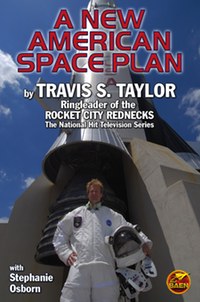Review: A New American Space Planby Jeff Foust
|
| “What NASA should be doing and Americans should be demanding is that the budget be $100 billion per year for the next decade,” he writes. |
Rest assured: it’s not The Situation, Honey Boo Boo, or any member of the Kardashian clan speaking out about what NASA should be doing. Instead, the reality star in question is Travis Taylor, the self-described “ringleader” of the Rocket City Rednecks from the television show of the same name on the National Geographic Channel. On the show, now in its second season, Taylor and his group mix some ingenuity and engineering expertise with the Southern lifestyle to put together some fun projects, from rockets to submarines.
One might assume that Taylor would take a similar approach in A New American Space Plan: how to get more done at NASA for less money, for example, or other innovative approaches. Instead, Taylor argues just the opposite, seeking a massive increase in NASA’s budget so it can accelerate development of heavy-lift rockets and spacecraft to return humans to the Moon and then go on to Mars. How much additional money is he looking for? “What NASA should be doing and Americans should be demanding is that the budget be $100 billion per year for the next decade,” he writes. That’s nearly six times NASA’s fiscal year 2012 budget of $17.7 billion.
Taylor never gives a detailed breakdown of how that $100 billion should be spent, but the figure appears to be based on a fatal fiscal miscalculation. Taylor argues that NASA’s budget has averaged $13–15 billion a year since its inception, which is about correct if measured in constant (corrected for inflation) dollars. However, Taylor then adjusts that already constant budget figure for inflation, claiming that $15 billion in 1965 dollars is about $200–250 billion, or at least $150 billion, today. That leads him to conclude, erroneously, that “NASA’s budget has been cut by at least a factor of ten since the Apollo program.” Measured correctly in constant dollars, though, and the peak of NASA’s budget in the mid-1960s is roughly twice the agency’s budget today, not ten times or more.
| In today’s austere fiscal climate—or, perhaps, in just about any other—this prescription from a reality TV star is little more than fantasy. |
A New American Space Plan is littered with comments and claims that are curious at best, or downright wrong at worst. He writes that there has been “some political talk within the Obama administration of letting the space station program die after a few more years,” without mentioning it was the current administration that pushed forward plans to keep the station operational to at least 2020. Later, when talking about going to Mars, he writes, “One of the big Mars mission proposals, the 100-Year Starship, is not very well thought out from the get-go.” In addition to not explaining why it well thought out, he fails to mention that the 100-Year Starship is interested not in Mars but, as the name indicates, interstellar travel (see “Building a starship’s foundation”, The Space Review, September 24, 2012.)
The writing in A New American Space Plan is also uneven. At times Taylor is very folksy, interspersing vignettes from the production of his show or his childhood into his discussion about what NASA should be doing. Other times, though, he gets very technical, with that personal tone of voice replaced by a dispassionate recitation of facts, including technical details that are more likely to bore or confuse readers than add to his arguments. One example: “After the LPOT increases the LOX pressure from 100 psia to 422 psia, most of the O2 is then routed to the HPOT (High Pressure Oxygen Turbopump—28,120 rpm) where the pressure is boosted to 4,300 psia.” That’s fine for a technical paper or manual, but less useful for a treatise about NASA’s future. In the book’s final chapter, which should summarize what his plan is, he goes into detailed tangent about what it takes to become an astronaut.
The most disappointing part of the book, though, is the rejection of his group’s use of ingenuity and innovation to build things on short timescales and small budgets for their TV show. NASA arguably already gets a sizable amount of money—its annual budget is more than twice that of the National Science Foundation, for example—but many people would probably conclude there are more effective, efficient ways to make use of that funding. Instead, Taylor argues for increasing NASA’s budget several times over, offering only typical justifications, from fear of falling behind China to technical spinoffs, for that huge increase. In today’s austere fiscal climate—or, perhaps, in just about any other—this prescription from a reality TV star is little more than fantasy.
